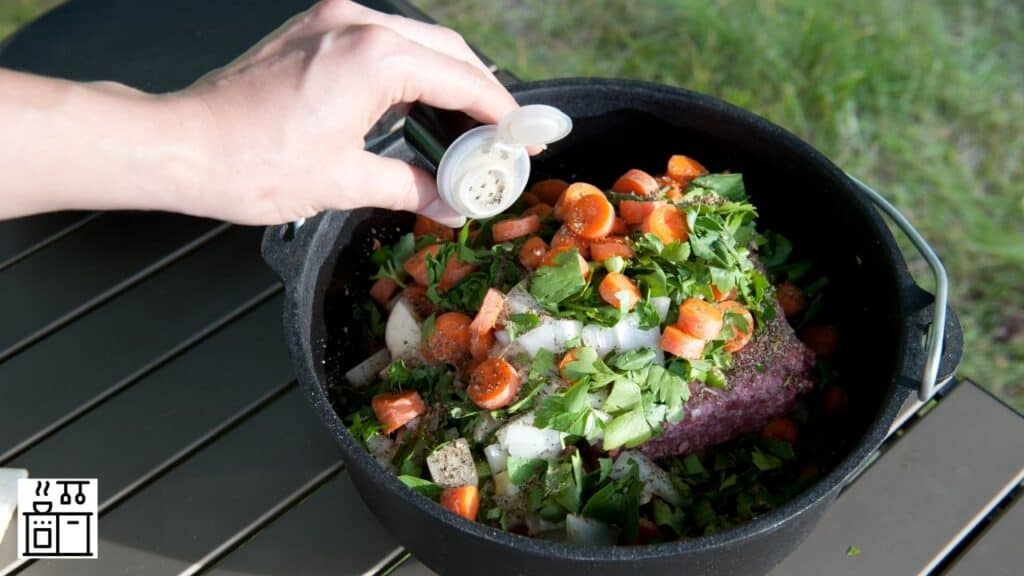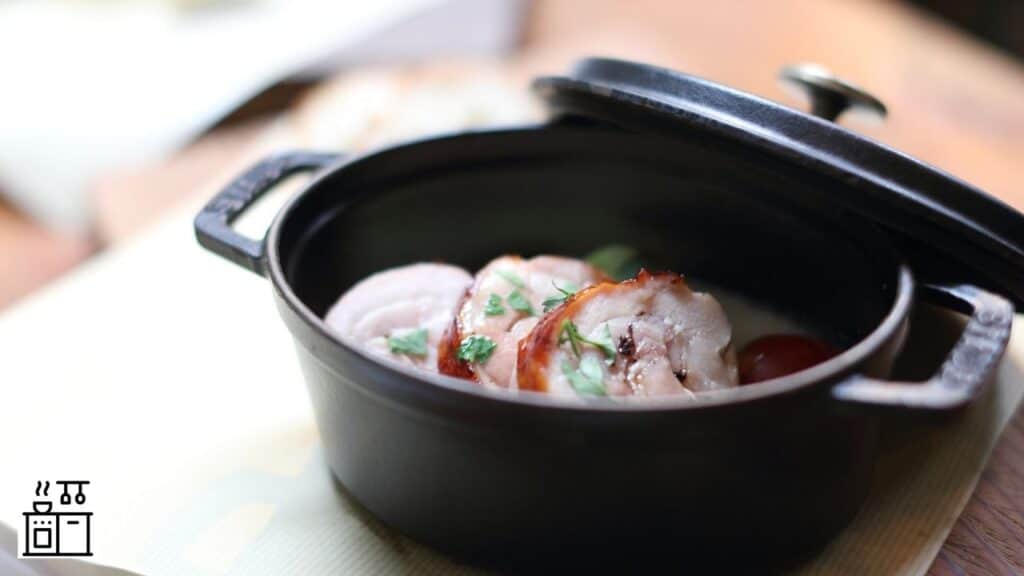Dutch ovens are perfect for any food that requires moist-heat cooking. But once all is said and done, what’s the best way to clean Dutch ovens? Are Dutch ovens dishwasher-safe?
Dutch ovens with enamel or ceramic coatings are dishwasher-safe. However, Dutch ovens made of cast iron or heavy metal aren’t dishwasher-safe. Even if you can wash a Dutch oven in a dishwasher, it’s better to hand-wash it. Repeated dishwasher use will make it dull and ruin its shiny enamel finish.
Do note that, in general, pots and pans of any kind shouldn’t be washed in the dishwasher, even though the manufacturers claim they’re dishwasher-safe. This includes bakeware, knives, and wooden items.
Are All Dutch Ovens Dishwasher-Safe?
In general, enamel-coated Dutch ovens and ceramic Dutch ovens are dishwasher-safe.
However, Dutch ovens without enamel finishes, such as pure cast iron or heavy metal Dutch ovens, aren’t dishwasher-safe.
Cast-iron and heavy metal Dutch ovens have microscopic pores that absorb the heavy suds created by the dishwasher detergent.
With time, the abrasive cleaner will not only ruin the seasoning of your cast-iron Dutch oven but also create unwanted rust.
Although enamel-coated Dutch ovens and ceramic Dutch ovens are dishwasher-safe, this doesn’t mean that you should start washing them in the dishwasher.
In fact, most manufacturers recommend hand-washing Dutch ovens, regardless of the construction.
Repeatedly washing enamel-coated Dutch ovens in the dishwasher will turn them dull and old-looking.
It may also ruin the enamel finish, thus leading to chipping, drying, and cracking.
If you don’t have time to hand-wash your Dutch oven or believe that hand-washing won’t clean the Dutch oven as well as the dishwasher, you can get away with dishwashing them once in a while.
But it’s best not to make a habit out of it to prolong the quality and appearance of your Dutch oven.
Recommended Further Reading:
How To Wash Dutch Ovens?
There are two common types of Dutch ovens: seasoned cast-iron Dutch ovens and enameled cast iron Dutch ovens.
Here’s how to properly wash both.
Seasoned Cast-Iron Dutch Ovens

Seasoned cast-iron Dutch ovens are protected and sealed with special oils through a process called polymerization or, as it’s more commonly known, seasoning.
Seasoning forms a natural non-stick layer that prevents your Dutch oven from rusting and deteriorating.
It also gives the Dutch oven its classic black patina.
If placed in a dishwasher, the seasoning of the cast-iron Dutch oven will weaken over time, leaving the cookware susceptible to rust, cracks, and chips.
This will force you to dispose of the pot and buy a new one.
With a bit of extra care, seasoned cast-iron Dutch ovens, particularly the high-quality ones, can last for generations.
Here’s how to clean seasoned cast-iron Dutch ovens:
- Let the Dutch oven cool down for 15 to 20 minutes, or until cool to the touch.
- Fill the Dutch oven with hot water to remove burnt or stuck residue.
- Once the water has cooled, scrub the interior of the Dutch oven with a brush scrubber or a chainmail-wrapped sponge to remove stubborn bits of food. Use a small amount of mild dish soap if necessary.
- Don’t scrub too hard, and avoid abrasive sponges as they could remove the seasoning of your Dutch oven.
- Rinse the pot and dry it with a power towel and cloth. Then, flip it upside-down and allow it to dry completely.
- When dry, season both interior and exterior with a small amount of cooking or seasoning spray. Wipe the extra residue with a paper towel.
And that’s it; you’ve successfully cleaned and re-seasoned your cast-iron Dutch oven!
When not in use, place the pot in a dry area.
To allow airflow, keep the lid next to the pot rather than on top of it.
If rust develops, clean the pot with a nylon sponge and dish detergent, and then dry thoroughly.
Rust usually forms when the pot isn’t sufficiently dried after washing.
To prevent the rust from reappearing, rub a small amount of cooking oil around the pot’s rim to create a sort of seal.
Then, place pot protectors between the rim and the lid.
Store in a cool, dry place, and don’t stack them under or on top of other cookware.
Related Further Reading:
- Is There Smoke When Using a Grill Pan?
- Can Grill Pans be Used in an Oven?
- What Pots Work With Induction? [And What Don’t]
Enameled Cast Iron Dutch Ovens
As the name suggests, enameled cast-iron Dutch ovens are regular cast-iron Dutch ovens but covered in non-stick porcelain enamel.
These types of Dutch ovens are much easier to wash than seasoned Dutch ovens and can occasionally be placed in the dishwasher.
Unlike cast-iron Dutch ovens, enamel Dutch ovens don’t rust and don’t need to be seasoned before and after use.
Here’s how to clean them:
- Let the pot cool to room temperature for 15 or so minutes before cleaning. Don’t ever place a Dutch oven in cold water or fill it with cold water if it’s still hot. This may crack the enamel due to thermal shock.
- Once cooled, soak the Dutch oven in hot water, mild dish soap, and about two tablespoons of baking soda for another 15 minutes. You can also use the Bar Keepers Friend Powder Cleanser in place of baking soda. This will soften any stubborn food residue or grime.
- Pour the water out and gently scrub the interior and exterior of the pot with a soft sponge or a dish scrubber. Never use steel wool pads or abrasive cleaners, as they may scratch and damage the enamel protection.
- Once the food residue is removed, wash the Dutch oven with mild dish soap and warm water, and then rinse it clean.
- Let the pot air dry in a drying rack or wipe it dry with a paper towel.
- Store in a cool and dry place.
If your enamel Dutch oven has stubborn stains or food residue that just won’t come out, don’t forcibly scrape it away.
Instead, make a paste with three parts baking soda and one part water and use it on the problem area.
Cover the Dutch oven with a lid and leave it overnight.
In the morning, scrub the stubborn areas with a dish scrubber, mild soap, and warm water.
Alternatively, you can leave the Dutch oven to soak overnight with a little baking soda or bring the baking soda-and-water mix to a simmer for about 8 to 10 minutes.
This should loosen any grime, stain, or residue it may have.
Are Lodge Dutch Ovens Dishwasher-Safe?
Yes, Lodge Enameled Cast Iron Dutch Ovens are dishwasher-safe.
Even so, Lodge recommends hand-washing the pot with a nylon scrub brush and warm soapy water to preserve the cookware’s shine and appearance.
Lodge advises users to avoid Citrus juices and citrus-based cleaners as they may dull the pot’s exterior gloss.
Interesting Further Reading:
- What is the Purpose of a Wok Ring?
- Do Stainless Steel Bowls Rust? [Why + How To Remove The Rust?]
- Can Quartz Handle Hot Pans?
Are Enamel Dutch Ovens Dishwasher-Safe?
As discussed above, most enamel Dutch ovens are dishwasher-safe.
But while this is true, it’s still better to wash them by hand to prevent them from turning dull.
Are Le Creuset Dutch Ovens Dishwasher-Safe?
Yes, Le Creuset Dutch Ovens are dishwasher-safe.
However, like Lodge, Le Creuset recommends hand-washing its cookware.
According to Le Creuset, constantly washing Dutch ovens in the dishwasher may lead to the dulling of the enamel finish.
Although this won’t affect the cooking performance, it’ll ruin the gorgeous shine of the Dutch oven.

